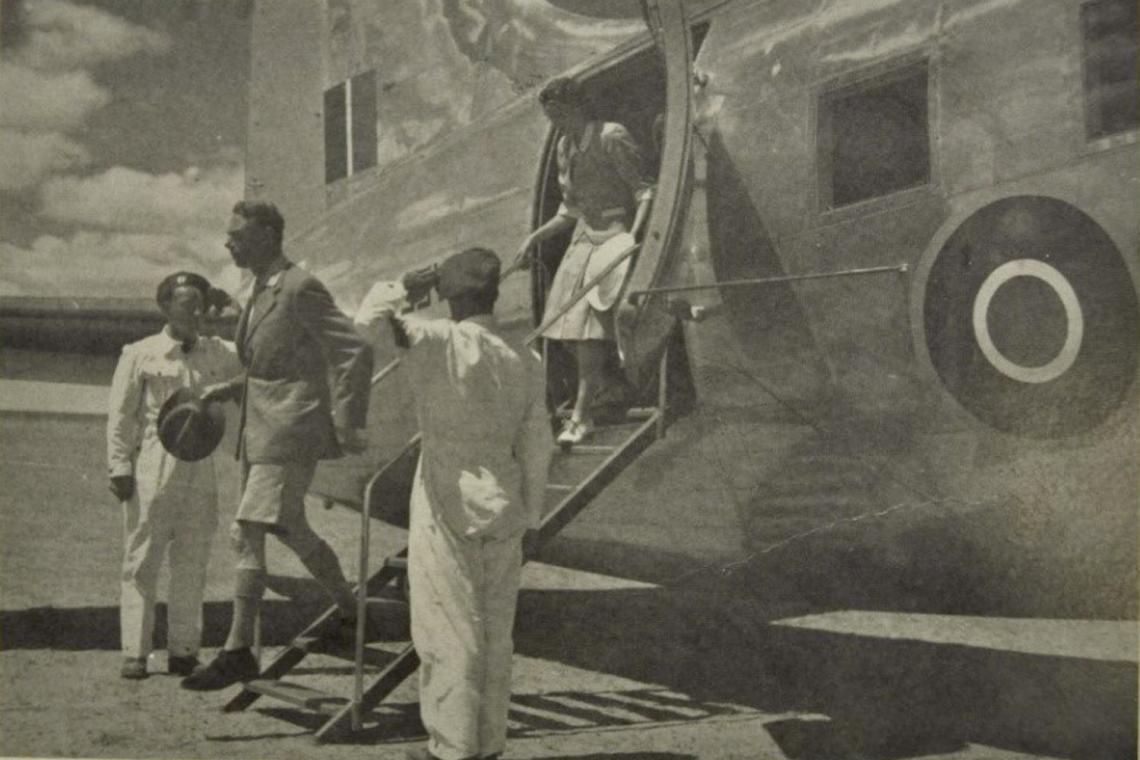In the heart of the Free State grasslands, where the golden fields shimmer before a late afternoon thunderstorm, there stands a lonesome road sign. The nails holding it up is rusted and old, the paint slowly being eroded away by weather and time. Tall grass nips at the edges of the sign, the posts barely keeping it aloft. There is only one word written on it. Sommerville.
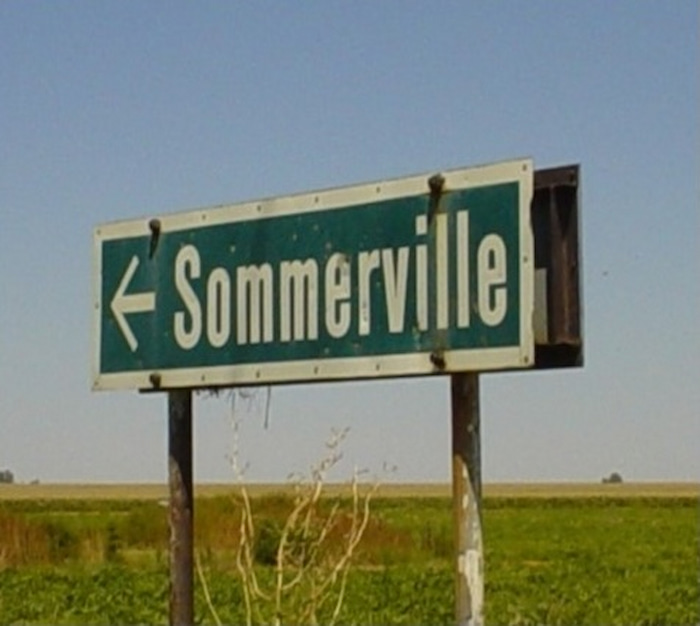
The only indication today of a once successful game reserve.
The Early Days of Sommerville: A Wildlife Sanctuary in South Africa’s Free State
The name is unfamiliar and long forgotten to most, but there are still a few senior citizens who will remember the fourth-proclaimed conservation area of South Africa. Originally, it was a farm in the Bultfontein district of the Free State province, owned by Mr J Sommerville (The Union’s Secretary of Lands). It exchanged hands to Mr Cook, (both) close friends of General Jan Smuts, then to the Smuts government in 1921 for an exorbitant price. Apparently, government officials only visited the land after the deal had gone through, only to deem it as a “worthless” piece of land.
Naturally, a meeting had to be scheduled to decide what was to happen to this piece of nothingness the government had bought. It was recommended by officials to cull the roaming game and then lease it to farmers for cultivation. After some consideration, they, however, decided to transfer the land to the Orange Free State Provincial Administration (PAO). After that had been done, the conservation-minded PAO executive committee decided to proclaim the ‘worthless land’ as a haven to protect the almost extinct black wildebeest, as well as to revive the large numbers of grassland game that historically roamed this part of the world. On 1 December 1925, the Sommerville Game Reserve was proclaimed under Ordinance no 8 of 1925 in extent 9 820 ha.
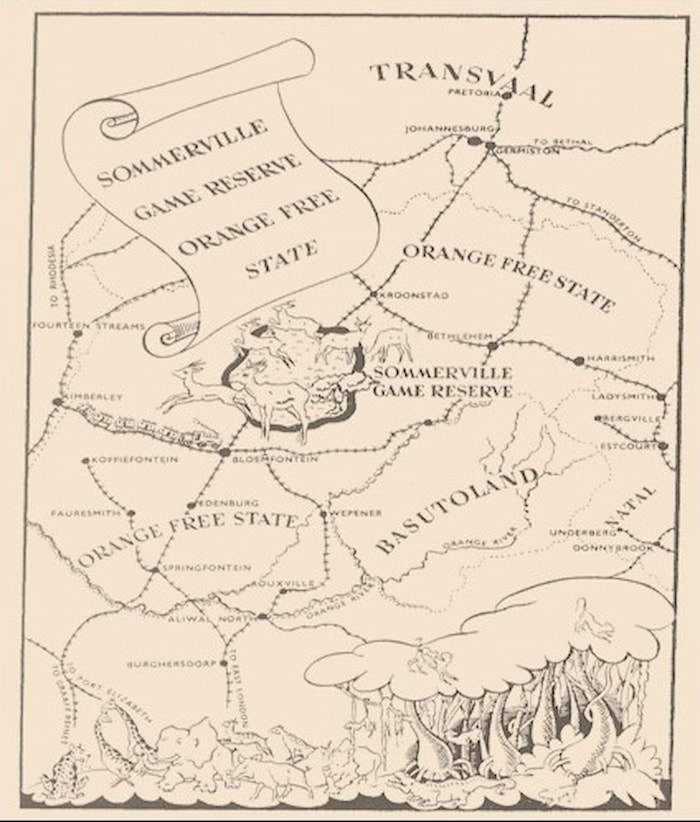
A historical map of the Sommerville Game Reserve, situated in the northwestern “Orange” Free State.
At first, Sommerville Game Reserve had no infrastructure, very little game and nothing but grasslands as far as the eye could see. It wouldn’t stay that way for long.
The PAO appointed three game wardens for the game reserve, generously compensating the chief game warden with about 5 pounds per month as salary, a free house, grazing rights for 30 cattle as well as 342 hectares of land to cultivate. The other two game wardens got the same compensation without the five pounds. They were also tasked to cultivate land for the PAO. The game reserve earned a massive £1,782 from the maize harvest in 1954 and £1,047 from game sales. Expenditure was £1,154, and the total profit for that year was £1,775. These three men, GJ Meiring, G Meiring and JJS Burger, were tasked to manage the wildlife and construct infrastructure.
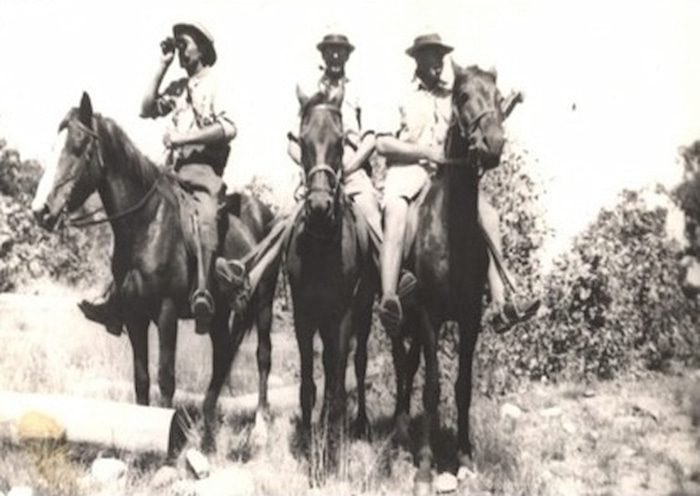
The three game wardens on horse patrol in the game reserve.
They installed windmills, created gardens, build houses and erected game fences. According to Mr Conradie, an ex-resident I visited, the game reserve had a fenced corridor all around it, from where the neighbouring farmers gained access to their farms, schools and town. Visitors also made use of the corridor for game viewing and the wardens used it to access the game reserve. The fence, which has long been lost to time, consisted of thirteen barbed wires and was lower than today’s 2,4-meter requirement for game fences.
But that was not all there was to the game reserve. One cannot have a game reserve without sufficient game, after all.
Originally, there were steenbuck, grey duiker, springbuck and blesbuck. According to Mr Conradie: ‘mosquitos, snakes and foxes were too many … springhare and porcupines were abundant … and vultures occasionally visited the area’. Later, it also became famous for housing and protecting the almost extinct black wildebeest. In addition to the original black wildebeest herd, five different farmers and the Wildlife Society of the Free State donated black wildebeests to the game reserve, contributing to their heterozygosity. Today, their offspring are highly sought after by stud game breeders throughout South Africa. By 1950, 3400 blesbok, 1300 springbok, 160 black wildebeest, 27 red hartebeest, 13 eland and 7 zebras roamed the game reserve.
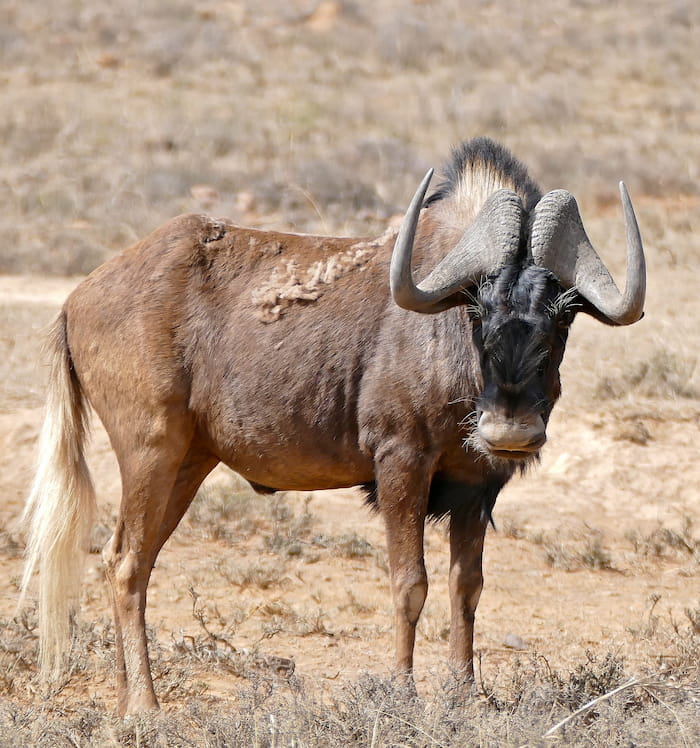
The protected black wildebeest. No longer endangered.
Also, in 1949 the Sommerville Game Reserve came into possession, in exchange for five springbucks that were donated to the Bloemfontein Zoo, of one camel bull. No word of what happened to it, but at least we can be reasonably sure it had enough grass to last it a lifetime.
In 1950, a total of 2 100 exotic Eucalyptus trees were planted on Forestry recommendation. In an official report, the game and plant life on the reserve was briefly referred to as veld and ‘game’s condition is good, bucks are fat’. Very informative.
Strangely enough, it seemed like the game reserve was not actually popular for game viewing, considering that it only had 160 visitors in 1954 compared to 65 in 1953. A slight improvement, but not enough to warrant popularity. On the other hand, the surrounding farmers had a ton of fun with the game reserve, seeing as one farmer set up an observation tower for himself. Here, he would watch the wildlife with a spotting scope, and one would assume that he invited friends over for a barbeque (braai) and have them spot wildlife from the tower as well.
Royal Visitors and Poachers: Sommerville’s Notable Moments
Other farmers would also try to sneak out some prime game meat for “biltong”. One story tells of two neighbouring farmers who attempted to poach a blesbuck ram. In the dead of night, they snuck into the game reserve, armed with a shotgun and taking turns to jump the fence. Unfortunately, they did not seem to have the right equipment for a nighttime raid, nor the right sense, seeing as one mistook the other for the prized blesbuck ram and shot him. In the butt!
Naturally, they didn’t want to get in trouble and decided to forego a visit to the doctor, handling it themselves. Again, they don’t seem to have been entirely prepared for this either, seeing as the one that was shot remained with a permanent limp. If anyone asked, it was an illness. Not any illegal attempts at blesbuck “biltong”.
The reserve also had some more well-known visitors, not only locals and amateur poachers. These visitors included a member of the board of Curators of National Parks (Senator MJ van Breda), delegates of the British Parliament, and Prince Josef Kamal of Egypt in 1944. Oh, and King George VI and the then Princess Elizabeth of England in 1947.
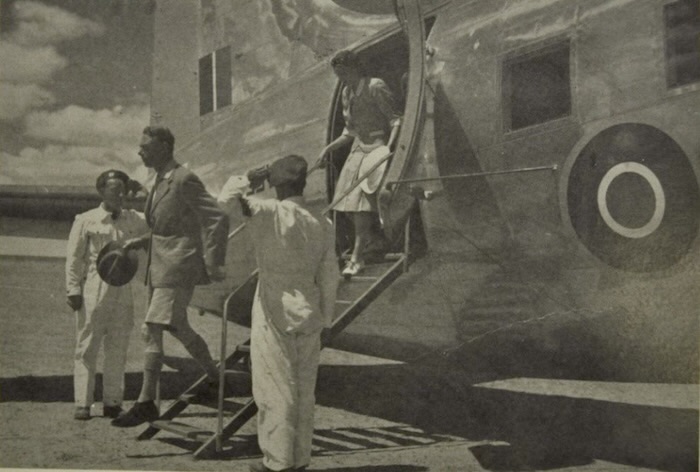
A photograph of King George VI descending the Royal Aeroplane for his day safari to the Sommerville Game Reserve. Photo: Found in Bultfontein 1874-1974 Grepe uit die Geskiedenis. Apparently, King George was not too happy about this excursion, seeing as he was not ‘appropriately dressed’ for the numerous onlookers at his safari.
The last two were, of course, more important than the rest, so a 25km road was specially built from the local town, Bultfontein, to the reserve in early 1947. So, when King George, Queen Elizabeth and their two princesses went on their one-day safari on the 8th of March, they only had to take a quick flight on one of the eight aircraft scheduled from Bloemfontein to Bultfontein (only a 100km trip) for the day and a short drive, to finally make it to the game reserve. Here, they could enjoy some tea while they viewed the thousands of blesbucks, springbucks and black wildebeest.

The primitive game capturing kraal erected of iron poles and steel wire to capture all the game for translocation. The mortality rate, shocking between 41 – 58% on the plains game, in those initial years of game capturing. Today, with improved technics, over 5% is rated high.
Why Sommerville Was Lost: The Politics Behind the Game Reserve’s Decline
So, we have a game reserve that is quite popular with the locals, colloquially referred to as ‘The Free State Game Reserve’, that has the King and future Queen of England, a prince from Egypt and many dignitaries as visitors. It also has some prime game that everyone wants a piece of no matter the bodily harm. But it’s not here anymore. What happened?
Politics, again, it seems.
In 1950 the Provincial Administration’s Executive Committee appointed Mr Willem Pretorius to negotiate with the Central Government to exchange the Sommerville Game Reserve for the Allemanskraal Dam government land in the Winburg district. In 1954, the Minister of Lands approved the exchange, and subsequently the new conservation area was proclaimed as the ‘Willem Pretorius Game Reserve’.
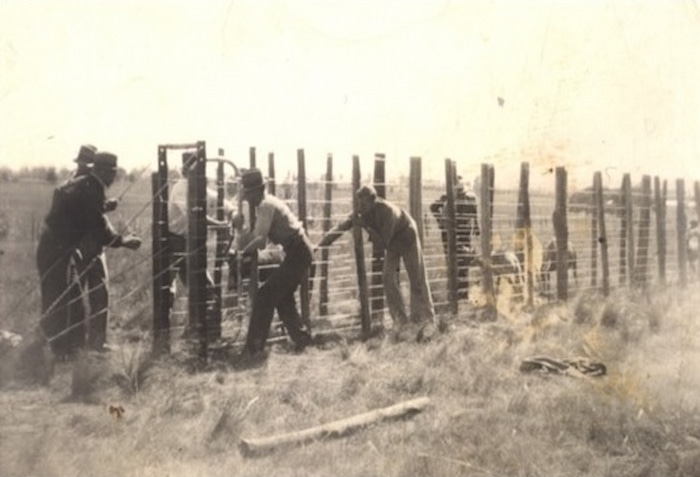
This new game reserve got some attention from the government, where a more functional game fence was erected. During 1956 all the game was captured at Sommerville, some sold to farmers and the rest translocated to other national parks and the remaining to the new Willem Pretorius Game Reserve. On 14 February 1961, it officially opened to the public. A year later, in 1962, the Department of Nature Conservation was established, with its head office at Willem Pretorius Game Reserve.

The remains of an old game warden’s house.
Sommerville’s Legacy Today: What Remains of the Once-Famous Reserve
And Sommerville? Well, in 1955, it was divided into 33 farms, each with about 257-282 ha of land. Each farm also came with a barbed wire fence, a fully equipped windmill with a cement reservoir, a two-bedroom house, and a small outbuilding that could be used for storage. These were all given for free to poor emerging farmers who applied.
One of these lucky applicants was Mr Conradie, who in 2013 still occupied the original house that he received in 1955.

Sommerville, now, 99 years since its proclamation.
Today, the once-successful Sommerville Game Reserve consists of several highly productive crop farms that provide food for the Free State Province’s food basket. The government finally got its wish to get rid of the roaming game and give the land to farmers for cultivation.
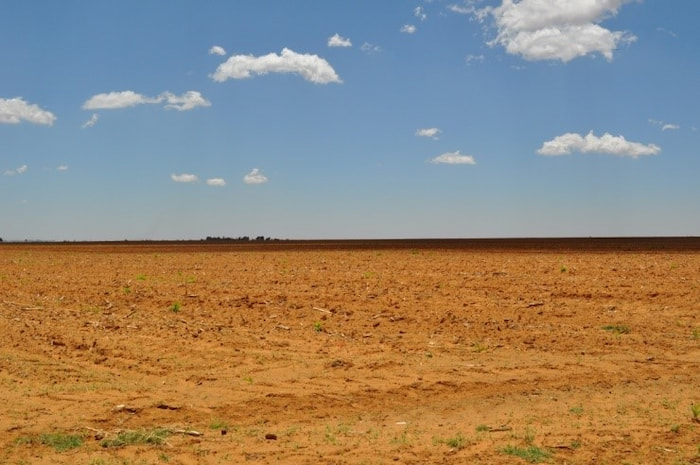
Waving grassy plains with rumbling herds of blesbucks and springboks were replaced with noisy tractors and rustling maize leaves. Vast grasslands with clear blue skies transformed into late afternoon dust storms. Wildlife is no longer found in the area. The natural field is ploughed for dissemination. Only unadorned land, a Sommerville road sign and a few 74-year-old alien Eucalyptus trees on the horizon remind you of the once illustrious Sommerville Game Reserve.

